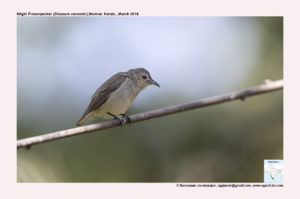Nilgiri Flowerpecker

Nilgiri Flowerpecker Dicaeum concolor
Etymology:
- Dicaeum: Greek word dikaion supposedly an Indian bird
- Concolor : Latin word for “ Plain ,Same colour”
Vernacular Names : Mar: Nilgiri Fultocha
Distribution in India: Resident of Western Ghats in India.
Description: Size of 7·5–9 cm; Wt. of 4–8 g. The nominate race is greyish olive-brown above, more olive on rump, with dark centres of crown feathers, pale forehead, lores and supercilium; wings and tail are darker. It is yellowish-white below, axillaries are white; iris is brown to dark brown; bill is black-tipped bluish-grey or black, dark horn-brown on culmen; legs are brownish-black or plumbeous. Both the sexes are similar. The juvenile is browner, duller and less olive than adult, with underparts more ashy. It also lacks dark feather centres on crown; part of lower mandible is yellowish, or bases of both mandibles are pale.
Habitat: It is found in evergreen, moist deciduous, submontane heath and montane forests, at edges; secondary growth, plantations and other cultivation, groves of trees in open country, and trees around habitation. It is found from sea-level up to 3660 m.
Food habits: It eats insects, spiders, figs, fruits and nectar of mistletoes. It forages in all storeys, but most frequently in canopy. It occurs singly, sometimes in pairs or in small groups.
Breeding habits: They breed in Jan–May and Sept in S India. Both the sexes build nest, incubate eggs, tend nestlings and care for young. The nest is a very small hanging purse. The nest is made chiefly of floss of silk cotton tree, and other fibres and vegetable downs, above ground in a tree or a tall bush, sometimes much lower among nettles and briars. They lay a clutch of 2–3 eggs. Food is delivered to chicks by adults every 2–5 minutes in nestling stage.